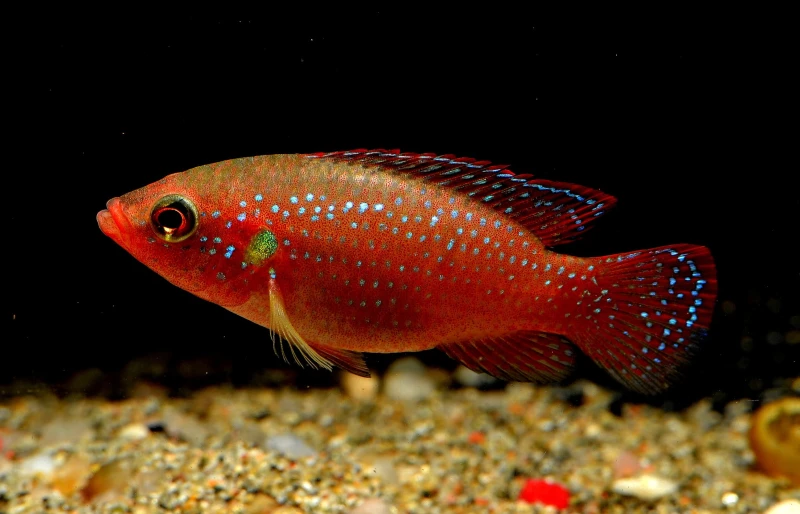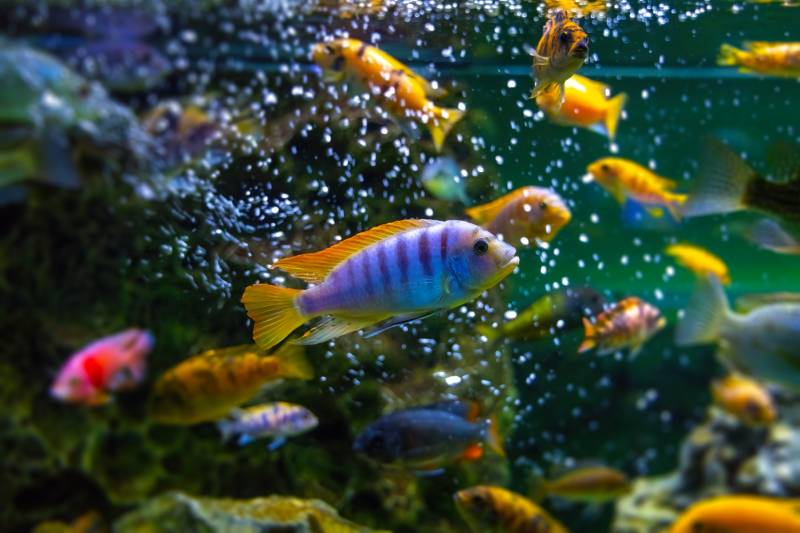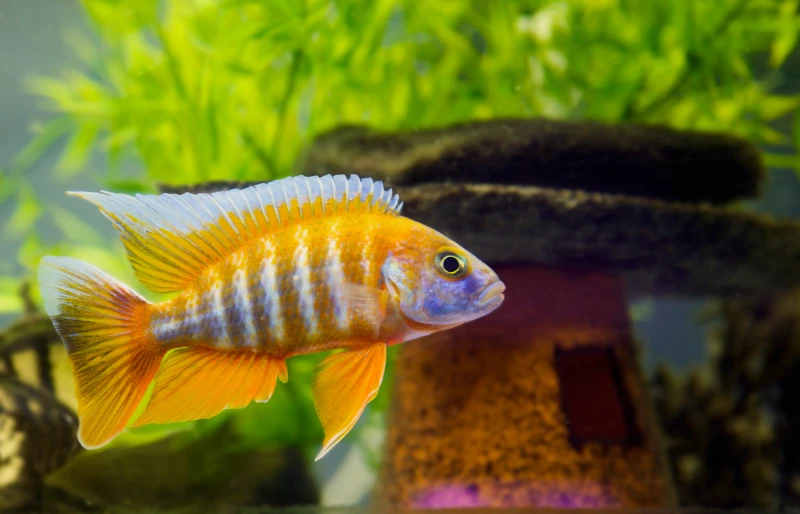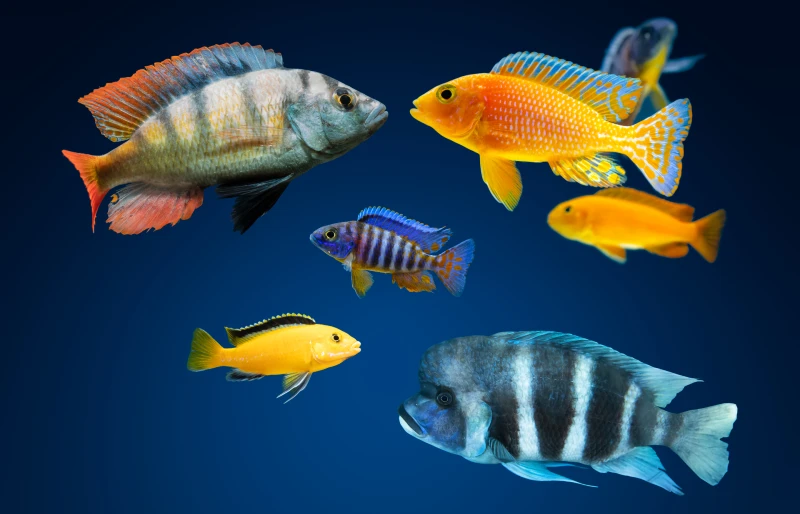
Click to Skip Ahead
Cichlids are some of the most popular aquarium fish, but many people may not be aware that the name “cichlid” covers a huge array of fish. In fact, there are two primary categories of cichlids: African and American. When it comes to African cichlids, there are over 1,200 individual species of fish that are native to the Cichlidae family, all native to the African continent. Depending on the species you choose, the care and needs can vary, but there are also a lot of similarities between the most popular African cichlids kept in aquariums.
African Cichlid Breed Overview
| Size: | 2–36 inches |
| Lifespan: | 5–20 years |
| Similar Breeds: | American Cichlids |
| Suitable for: | Variable based on species |
| Temperament: | Territorial, social, active, aggressive |
African cichlids are extremely popular fish, primarily because of their tendency to be active and social. They are commonly spotted interacting with humans through the glass, as well as other fish in their environment. They tend to be curious, but also territorial. They can be aggressive, and they also have very specific care needs that can make these fish difficult for beginners. To top it off, some cichlid species can also get quite large and unmanageable for the average home aquarium, so it’s essential to understand what to expect from a species before bringing your new fish home.
Characteristics
African Cichlid Cost
All African cichlids are native to the African continent, with a multitude of species coming primarily from the Malawi and Tanganyika Lakes, located in Central Africa. Although there are well over 1,000 African cichlid species, only a few dozen pop up in the aquarium trade, with around 20 species accounting for the majority of African cichlid specimens in home aquariums.
The cost of a cichlid will vary depending on the type of fish you are seeking. In general, the more common species can retail for between $5 and $20 per fish. However, some high-quality fish or uncommon species can easily sell for $50 or more, with some specimens selling for upwards of $500. Many African cichlid species are happiest when kept in breeding pairs, so you may need to invest in more than one fish at a time.

Sociability of the African Cichlid
Do These Fish Make Good Pets?
African cichlids make great pets thanks to their active and social nature. Their complex care needs make them unsuitable for beginners, though. With proper care, you can expect African cichlids to be interactive, and the happier and healthier they are, the brighter their colors will be and the more active they will act.
Does This Fish Make a Good Tankmate?
Whether they make suitable tankmates varies based on the species of African cichlid. Flowerhorns, Jewel cichlids, and Lionhead cichlids are often considered too aggressive to be kept with other fish. In some cases, they shouldn’t even be kept with a same-species mate.
Agassiz’s Dwarf cichlids and Electric Yellow Lab cichlids can be good options for community tanks, although they do still need enough space to reduce territorial behaviors. Other African cichlids, like Mbuna cichlids, Peacock cichlids, and Frontosa cichlids, can be kept in certain community settings.

Care Guide & Tank Set Up
Water Quality, pH & Temperature
The native waters for African cichlids are extremely alkaline, so these fish will thrive in a tank with a pH between 8.0 and 9.0, although most species can do well with a pH as low as 7.2. They are sensitive to shifts in pH, so aim to maintain the pH level of the tank rather than chasing a specific pH level.
They prefer hard water, with the ideal general hardness level ranging from 9–18 dH. African cichlids also prefer warmer water than many other aquarium fish, with their preferred temperatures ranging from 74–82°F.
Substrate
The ideal substrate for African cichlids is a substrate that is intended specifically for these fish. African cichlid substrates are designed to help buffer the pH, maintaining an alkaline pH level and reducing the risk of pH shifts. These substrates are typically some form of sand, which is great for meeting the digging needs of many African cichlid species.
Plants
Due to the unusual water parameters required by African cichlids, it can be difficult to find ideal plants. On top of the water parameter issue, cichlids are notorious for uprooting plants. Oftentimes, plants that are kept emersed with their roots in the water are recommended, like pothos, lucky bamboo, and mangroves. Submerged plant options include Java fern, Java moss, Anubias, hornwort, and red tiger lotus.

Lighting
African cichlids in the wild receive around 8 hours of bright lighting per day, so you should aim to replicate this in your aquarium. Lighting should also be appropriate for maintaining the plant life in the tank. Avoid leaving the lighting on for too long every day, though, since this can lead to algae overgrowth.
Filtration
African cichlids can be messy fish with a high bioload in their tank, so excellent filtration is necessary for maintaining water quality. It’s recommended that your filtration system can filter at least four to six times your tank’s volume per hour. This means that a 30-gallon African cichlid tank will need a filter that turns over at least 120 gallons per hour.
Things to Know When Owning an African Cichlid:
Food & Diet Requirements
The diet requirements of your African cichlids will depend on the species. Most African cichlid species are herbivorous, but there are a few carnivorous and omnivorous species as well. Regardless of the natural dietary needs of your African cichlids, African cichlid food is formulated to meet the nutritional needs of all African cichlids. For herbivorous species, you can offer fresh vegetables and algae multiple times per week, while carnivores will appreciate treats like brine shrimp and bloodworms.
Size & Growth Rate
The size and growth rate of African cichlids varies based on the species. Most African cichlids in the aquarium trade don’t exceed 8–12 inches in length, but there are some uncommon species that can reach lengths of up to 36 inches.

Varieties
With so many African cichlid species in the world, there’s no way to name them all. Here are some of the most popular species that you’re likely to encounter in the aquarium trade:
Lifespan and Health Conditions
The lifespan of African cichlids varies by species, as well as other factors, like genetics, diet, and quality of care provided. With proper care, some species can live up to 20 years in captivity.
Male vs. Female
There aren’t a whole lot of differences between male and female fish. Generally, males tend to be larger with brighter colors, though.
3 Little-Known Facts About African Cichlids
1. There Are Variations in Jaw Shape, Depending on the Species
2. New Species of Cichlids Are Discovered Every Year
3. Just Three Lakes (Victoria, Tanganyika, and Malawi) Have Over 500 Species

Final Thoughts
Researching the specific African cichlid species you are interested in bringing home is extremely important. Some of these fish are far more suitable for community tanks than others, while some will do best kept alone or only in breeding pairs. The water parameters and tank size vary between species, but in general, it’s best to provide as much space as possible with these fish. This is especially important if you intend to try to keep your African cichlids with tankmates. Regardless of the species, these fish have complex care needs that can make them extremely difficult for beginners.
Featured Image Credit: Arunee Rodloy, Shutterstock
The post African Cichlid: Care Guide, Pictures, Tank Setup & Info appeared first on Pet Keen.





